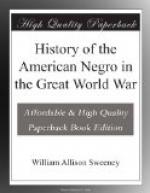“On the way back it seemed the whole war was turned on me. One bullet passed through my trousers and it made me hop, skip and jump. I saw a shell hole six feet deep. Take it from me I dented it another six feet when I plunged into it. In my fist I held the captain’s can of coffee.
“When I climbed out of the hole and started running again a bullet clipped a hole in the can and the coffee started to run out. But I turned around stopped a second, looked the Kaiser in the face and held up the can of coffee with my finger plugging up the hole to show the Germans they were fooled. Just then another bullet hit the can and another finger had to act as a stopper. I pulled out an old rabbit’s foot that my girl had given me and rubbed it so hard the hair almost came off.
“It must have been the good luck thing that saved my life because the bullets were picking at my clothes and so many hit the can that at the end all my fingers were in use to keep the coffee in. I jumped into shell holes and wriggled along the ground and got back safely. And what do you think? When I got back into our own trenches I stumbled and spilled the coffee.”
Not only did Lieutenant George Miller, battalion adjutant, confirm the story, but he added:
“When that boy came back with the coffee his clothes were riddled with bullets. Yet half an hour later he went out into no man’s land and brought back a number of wounded until he was badly gassed. Even then he refused to go to the rear and went out again for a wounded soldier. All this under fire. That’s the reason he got the D.S.C.”
Corporal Elmer Earl, also of Company K, living in Middletown, N.Y., won the D.S.C. He explained:
“We had taken a hill Sept. 26 in the Argonne. We came to the edge of a swamp when the enemy machine guns opened fire. It was so bad that of the 58 of us who went into a particular strip, only 8 came out without being killed or wounded. I made a number of trips out there and brought back about a dozen wounded men.”
The proudest recollection which Negro officers and privates will carry through life is that of the whole-hearted recognition given them in the matter of decorations by the French army authorities. Four colored regiments of the 93rd division attained the highest record in these awards. These regiments being brigaded with the French, their conduct in action was thus under their observation. Not only was each of these regiments cited as a unit for the Croix de Guerre, but 365 individual soldiers received the coveted decoration. A large number of Distinguished Service Crosses were also distributed to the 93rd division by General Pershing.




